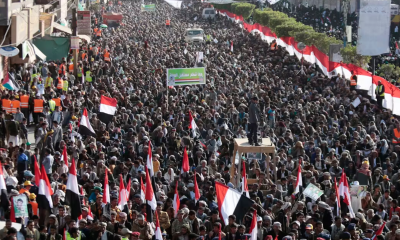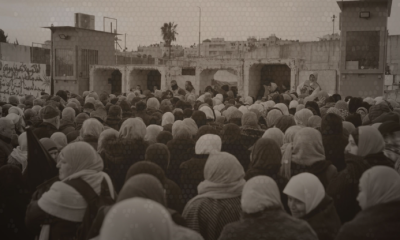Islam
The literature of Islamic Resistance، inspiration from the Revolution in Iran

The political literature of Islamic Resistance that influence and inspiration drawn from the Islamic Revolution in Iran
Hezbollah in Lebanon is one of the most renowned and significant Shia Islamist groups that has emerged in the Islamic world and has left a substantial impact on the international stage. This movement has achieved considerable success since its inception and has become a symbol of Lebanon’s national pride and power. The political literature and slogans of Hezbollah indicate its influence and inspiration drawn from the Islamic Revolution in Iran .
From 1982 to 2000 CE (1361 to 1379 SH), Hezbollah underwent various stages in social, political, and military realms, transforming from a relatively insignificant entity into a significant challenging force against Israel. It should be noted that in recent decades, this movement has evolved from a minor player to a major concern and primary focus for the Israeli regime, particularly in the military domain. Hezbollah, by adopting a strategy of resistance against occupation, gradually pushed Israeli forces back to the southern borders of Lebanon, ultimately compelling Israel to withdraw from southern Lebanon in 2000 CE (1379 SH), except for the Shebaa Farms and Kfar Shuba hills. Hezbollah’s victory in 2000 marked a turning point in the history of this movement and in the confrontation between the Islamic world and the Israeli regime.
From a Western analytical perspective, Hezbollah is seen as an evolving Islamic Jihadist movement. However, using the term Jihad should not lead to the assumption that Hezbollah is inherently an extremist and violent group. While its initial goals were military resistance against Israel, and this resistance remains its raison d’être, its objectives are not solely military. The interaction of this movement with Christian and Sunni actors in Lebanon’s political arena, even with factions having nationalist inclinations and active involvement in the country’s politics, sometimes rooted in ethical principles drawn from the philosophy of Greater Jihad, underscores this fact. Therefore, Hezbollah is not merely a political party but a pervasive movement with strong popular support, both in Lebanon and in the Islamic world. It is one of the most robust anti-Zionist Shia Islamic movements in proximity to Israel, sharing the most ideological and political similarities with the discourse of resistance originating from the Islamic Republic of Iran.
By examining the unfolding events, one can infer that Hezbollah’s operations and the Israeli retreat to the “Security Belt” in southern Lebanon had significant and far-reaching consequences. In reality, this withdrawal from southern Lebanon was not just an Israeli concern; it was also a concern for the revival of Shia radicalism and the spread of Hezbollah’s methods of resistance to Muslims in Gaza and the West Bank, as well as along the Jordanian border. This apprehension soon materialized with the onset of the Palestinian uprising. The expulsion of Israel from southern Beirut at this critical juncture marked the most significant political-military victory for Hezbollah and the discourse of resistance. It was the first time in the struggle against the Israeli regime that they attributed a defeat to it, with Arab armies being incapable of achieving this.
Among the prominent actors in the realm of the Hamas resistance discourse is Hamas itself. The Islamic Resistance Movement Hamas is a Palestinian Islamic political and military organization. It was founded in 1987 under the leadership of Abdul-Aziz Rantisi and Sheikh Ahmed Yassin as a Palestinian branch of the Muslim Brotherhood. Its declared goal is the “liberation of all of Palestine.” However, due to differences of opinion on how to deal with Israel, this movement separated from the Muslim Brotherhood and declared its existence in 1987. Hamas has cooperated with the autonomous Palestinian government, become involved in its most significant affiliated institutions, and even, in 2006, transformed into the ruling party of the Palestinian Legislative Council through successful elections. Ismail Haniyeh, one of the leaders of Hamas, was appointed as the Prime Minister of the autonomous Palestinian government.
Islamic Jihad Movement in Palestine, This movement is a Palestinian political and military organization formed based on the ideology of Imam Khomeini (RA). It was established in the late 1970s by three Palestinian students in Egypt: Fathi Shqaqi, Abdel Aziz Awdeh, and Basher Mousa, as a part of the Islamic Jihad in Egypt. In fact, the Islamic Revolution in Iran can be considered the most influential factor in this movement’s formation. This movement introduced the slogans of Islam, Jihad, and the liberation of Palestine, in which Islam served as the starting point, Jihad as the means, and the freedom of Palestine as the ultimate goal. Among Palestinian groups, Islamic Jihad shares the closest affinity with Hamas. Both are Islamic-oriented, do not recognize Israel’s existence, and engage in fighting with the goal of its destruction.
The summer of 2006 witnessed provocative actions that were ordinary but had always been occurring between Israel and Hezbollah since 2000. However, this time, it escalated into a devastating war. In this regard, Gideon Steinberg, a West Asia expert, in his book “The Foundation of Science and Policy,” believes, “Of all Israel’s wars since 1948, this was the only one in which Israel did not emerge victorious. In fact, it prepared for it poorly, despite the fact that it was foreseen immediately after the Israeli withdrawal from Lebanon in 2000.”
Regarding the results of this war, it can be said that after 33 days of war, which involved both sides bombarding each other’s territories, on August 11, 2006, according to UN Security Council Resolution 1701, Hezbollah was called upon to retreat to the Litani River (to establish the Lebanese army and peacekeeping forces) and Israel was called upon to withdraw from southern Lebanon. The war came to an end. Since after every clash, the involved parties consider themselves victorious, examining the pre-war goals, performance during the war, and post-war consequences will clearly determine the extent to which the pre-designed objectives were achieved. Israel’s primary objectives in this war included attempts to disarm Hezbollah by damaging its operational efficiency and sending a punitive message to the leaders of Lebanon. In reality, attempting to disarm Lebanon through the air was not practical because the Israeli air force had no means to destroy the weaponry, most of which was concealed in hidden depots.
Therefore, the set of consequences stemming from the extensive actions of Israeli military experts about the Israeli army’s inability to eliminate Hezbollah and increasing doubts about Israel’s deterrent capabilities led the former head of the Israel Defense Forces, General Dan Halutz, to speak about Israel’s failure in its military operations against Hezbollah fighters, questioning the validity of Israel’s military actions in this conflict.
After the expulsion of their own forces from Gaza by Hamas and the dominance of this movement over the strip, Israel imposed restrictions on this area. On the other hand, the security agreement between Egypt and Israel, signed on June 17, 2007, disrupted the access of Hamas and Palestinian jihadist groups from Egypt. These groups launched scattered attacks against Israel, which led to reciprocal reactions from Israel, eventually resulting in a 22-day war. This war started on December 27, 2008, and ended on the night of January 17, 2009, after three weeks of military operations and with Egyptian mediation. The indirect negotiations between Hamas and Israel concluded with a ceasefire agreement in which both parties agreed to refrain from armed operations on each other’s soil. Regardless of delving into the causes of the war, it should be noted that the 22-day war had significant effects and consequences. The most important of these include:
- Shake-up in Israel’s Security Doctrine: The war challenged Israel’s security doctrine, which had been in place for years. It revealed the limitations of Israel’s military capabilities and its ability to address threats from non-state actors like Hamas.
- Damage to Israel’s Image: Israel’s image and reputation were tarnished on the international stage during the war. The high civilian casualties and destruction in Gaza drew significant international criticism and condemnation.
- Enhanced Regional Resistance: The war strengthened the local and regional position of the resistance movements and brought about changes in the balance of power in West Asia. It marked a significant shift in the regional dynamics.
As in the recent war between Gaza and Israel, all these cases were repeated again, and we will witness the defeat of Israel, hoping to God.
The 22-day war can be seen as the culmination of a strategy to isolate and contain the resistance movement in the West Asia region. After the United States faced consecutive failures in establishing its desired order in West Asia, particularly through the Greater Middle East Initiative, American policymakers sought to rectify their previous failures during the final months of the Bush administration. It is notable that Israel, in the past, confronted a cohesive front of Islamic and Arab countries. However, it gradually dismantled this front by establishing relations with some Islamic countries and initiating the Oslo negotiations. The rise of Iran’s power and influence in the region, along with the Arab leaders’ increasing reliance on the United States, led to a gradual transformation of the regional political landscape.

You may like
-


Conflating Judaism and Zionism only strengthens Israel: Jewish Activist
-


“Western Double Standards in Addressing Conflicts in the Middle East and Ukraine”
-


“Harris-Trump Debate Sparks New Controversies in U.S. Political Landscape”
-


“Netanyahu’s Strategy Crumbles as Hezbollah Expands Battlefield: Refugee Crisis Worsens”
-


The inspiration of Iran’s Islamic revolution on Yemen’s Islamic resistance movements
-


Islamic Resistance of Yemeni Shiites based on religious beliefs and values


Bloodshed in the Shadows: West Bank Crisis Deepens as Gaza Dominates Headlines

An anti-Semite is now someone Jews don’t like

Negotiations a way for coercive govts. to impose new demands that definitely won’t be fulfilled

The imposition of new U.S. sanctions on Iran and its contradiction with the U.S. announcement of negotiations.

Iran key AI player in Persian Gulf region, ready for cooperation: ICT Minister

An anti-Semite is now someone Jews don’t like

Bloodshed in the Shadows: West Bank Crisis Deepens as Gaza Dominates Headlines

Jewish parties foreign policy

Will Israel adhere to its commitments under the ceasefire agreement?

“Western Double Standards in Addressing Conflicts in the Middle East and Ukraine”

“Harris-Trump Debate Sparks New Controversies in U.S. Political Landscape”

Challenges Facing the U.S. Navy: Addressing Gaps in Strategy and Capability


